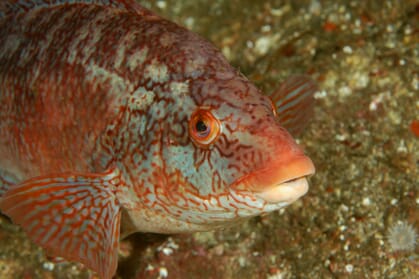When did wrasse first become recognised for their ability to pick ectoparasites off other fish?
Cleaning behaviour by fish has been observed most frequently in tropical fish, however it was Potts who first reported in 1973 that several wrasse species in the UK had the ability to clean parasites from fish kept in aquaria. This was confirmed by observations in the field in the early 1980s by Hilden.

When was this trait first exploited by the Scottish salmon industry?
The first commercial trials [using wrasse to control sea lice numbers] took place in the Shetland Islands in 1989 and the first successful commercial trials in mainland Scotland in 1990. By 1991, seven companies were using wrasse as cleaner fish.
Why did the initial phase of using wrasse come to an end?
Well, it is not quite evident whether the use of wrasse came to an end as such. From speaking with the Marine Scotland fish health inspectors, there has been continual use of wrasse in the aquaculture industry since the late 1980s. The introduction of emamectin benzoate [sold as Slice] in 2000 may have tapered the expansion of wrasse, but there remained on average some 17,000 kg of wrasse caught each year between 2000 and 2013 by UK-registered vessels.
What other fisheries are exploiting wrasse in Scotland and what are those wrasse caught by other fisheries used for?
The data that is submitted does not list the intended destination of wrasse. It could be for cleaner fish use in salmon farms or, perhaps, for human consumption.
How comprehensive are the Marine Scotland Science data on wrasse exploitation and are efforts to increase these data being made?
All fishing activity is reported to Marine Scotland compliance using FISH1 forms for vessels under 10 m, which cover the vast majority of vessels capturing wrasse in Scottish waters. These require details such as date, location, gear, species and caught weight. Additionally, sales notes are submitted by registered buyers and sellers detailing sales of all fish transactions, including those of wrasse. The completion of these forms are legal requirements, so the collection of data is comprehensive.

However, as the wrasse fishery is only recently a targeted fishery, the identification of wrasse was not species specific. The forms have recently been updated and now the actual species of wrasse are required to be detailed.
Is there a degree of self-regulation practiced by the aquaculture industry in their use of wild-caught wrasse?
From my interactions with people within the aquaculture industry there is a preference for wrasse of 12-24 cm. This is useful as it allows the majority of individuals to reach spawning size, whilst avoiding taking large highly fecund individuals. Additionally, the demand for wrasse seems to follow the population dynamics of sea lice on farmed salmon, resulting in over 95 percent of sales of wrasse by weight occurring between August and December. This is after the wrasse spawning season. These two aspects create continued recruitment opportunities for wrasse populations.
What sort of price do wrasse fetch?
A study by CEFAS earlier this year reported a range of £1 -£17 per fish.
What are the main gaps in our knowledge relating the status of Scotland’s wrasse stocks and how to ensure they are exploited sustainably?
This is quite a lot which is known about the biology of the wrasse species caught in Scottish coastal waters. There are five species – ballan, cuckoo, goldsinny, rock cook and corkwing – caught. They each have different life-histories with varying sizes and lifespans, age of maturity, fecundity rates, some change sex, some have nesting behaviour, some are highly territorial.
Further exploration is needed with regards to broader questions such as population age structure, habitat preference and larval dispersal, which may help identify stock units. There are also aspects relating to fisher activity such as catch effort, gear use and selectivity, and location of activity.
Has there been any evidence of a decrease in wrasse numbers and, if so, has this been shown to have any impact on other parts of the marine ecosystem?
There is no information relating to the population trajectories of each of the species, simply because of the [young] age of the targeted fishery.
